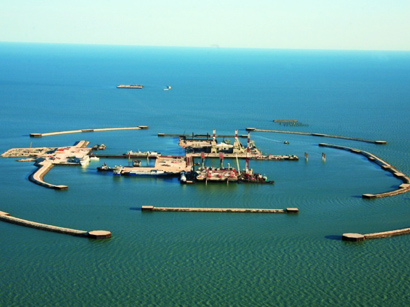Kashagan field and bright prospects of oil output in Kazakhstan

By Trend
In recent years, oil production in Kazakhstan has been steadily declining.
Oil is the main export product of Kazakhstan, and the country made every possible effort to increase oil production. However, the majority of Kazakhstan’s fields have already passed their production peak, and the oil output is getting low at these fields for natural reasons.
According to the Agency of Statistics of Kazakhstan, 81.79 million tons of oil and gas condensate were produced in 2013, 80.83 million tons of oil and gas condensate were produced in 2014, 79.46 million tons were produced in 2015 and 78.04 million tons in 2016.
But, it seems, the period of decline in oil production has remained in the past, and starting from 2017, Kazakhstan expects stable growth in oil output. The positive changes at the three largest Kazakh oil fields - Kashagan, Tengiz and Karachaganak, make it possible to hope that the situation will get better.
Oil production at the Kashagan field, the recoverable reserves of which amount to approximately 9-13 billion barrels of oil, was launched in the fall of 2016. Before that, the start of production at the field was postponed several times.
According to the Kazakhstan’s KazMunayGas company, more than 2 million tons of oil have been produced so far at this largest oil field discovered for the last 40 years. By the end of 2017, it is planned to increase oil production at the Kashagan field to 370,000 barrels per day.
For comparison, currently, the total oil and condensate production in Kazakhstan at all fields is about 220,000-240,000 barrels per day, which is 1.5 times less than it is expected by the end of 2017 at the Kashagan alone. This is while last summer, before oil production at the Kashagan started, the daily oil production in Kazakhstan was even less and amounted to about 180,000 barrels.
With the start of oil production at the Kashagan field, the forecasts of several international organizations on oil production in Kazakhstan immediately grew.
Analysts from the International Energy Agency (IEA), OPEC, the Energy Information Administration of the US Department of Energy (EIA) link the increase in oil production namely with the Kashagan field. Key international financial organizations name the Kashagan field the main contributor of Kazakhstan’s GDP growth.
Thus, the significance of the Kashagan field for the oil sector of Kazakhstan is difficult to overestimate.
The situation regarding the two other major oil-producing projects in Kazakhstan, Tengiz and Karachaganak fields, is also encouraging.
The oil production of Tengizchevroil company, which develops the Tengiz field, has reached a record level of 27.56 million tons of oil in 2016. At the same time, the Tengiz oil field expansion project is being implemented. It will increase production at the field by approximately 12 million tons per year up to 39 million tons per year. Finally, it was possible to agree on the cost of this project after long discussions in 2016. The first oil is planned to be obtained in 2022 as part of the project.
A record production level of 142.5 million barrels was observed at Karachaganak field in 2014, while it slightly decreased in further years. However, an expansion project is also planned to be carried out at the field, which will increase production in the long term, although no final decision has yet been made on this issue.
In other words, even if new deposits are not discovered as a result of geological exploration in Kazakhstan, three oil giants, namely, Tengiz, Karachaganak, Kashagan, will be able to bring Kazakhstan's oil production to a new level in the coming years.
It seems that for the last time we will face with the decline in oil production in Kazakhstan in the next few years, which is necessary to fulfill the country's obligations as part of the agreement concluded with OPEC in late 2016 to maintain oil prices.
Then Kazakhstan agreed to reduce oil production by 20,000 barrels compared to November 2016.
However, in practice, production has not decreased in Kazakhstan since early 2017, but on the contrary increased.
However, as the obligations to cut oil production are assumed on average for January-June, rather than for each month separately, Kazakhstan can still fall within the scope of the agreement if oil production is greatly reduced in the next two months.
Last week, Kazakh Energy Minister Kanat Bozumbayev assured that it would be reached.
Oil production will increase in Kazakhstan after the expiration of the agreement in late June.
Previously, Bozumbayev said that Kazakhstan will be unable to reduce oil production any more, but it will be able to increase it even if the agreement on the reduction of oil production is extended.
In its latest oil market review, OPEC mentioned Kazakhstan among the four countries that will make the biggest contribution to an increase in oil production in 2017 after the US, Brazil and Canada.
---
Follow us on Twitter @AzerNewsAz
Here we are to serve you with news right now. It does not cost much, but worth your attention.
Choose to support open, independent, quality journalism and subscribe on a monthly basis.
By subscribing to our online newspaper, you can have full digital access to all news, analysis, and much more.
You can also follow AzerNEWS on Twitter @AzerNewsAz or Facebook @AzerNewsNewspaper
Thank you!
